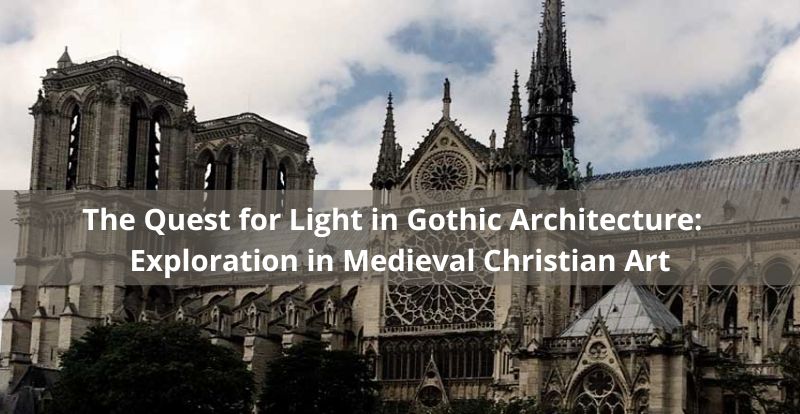The Quest for Light in Gothic Architecture: Exploration in Medieval Christian Art
The Quest for Light in Gothic Architecture: Exploration in Medieval Christian Art. In the vast tapestry of medieval Christian thought and expression, few concepts shine as brightly as that of light. Light, both as a physical phenomenon and as a symbol, held profound significance, serving as the embodiment of truth, beauty, and divine order. This reverence for light permeated the medieval Christian worldview, shaping not only theological discourse but also artistic endeavors, particularly during the era of the Gothic period.
It may interest you: Raising the Cathedrals: The Majesty of Gothic Architecture
Video: Let's discover the amazing Gothic Architecture features!

Gothic architecture: exploration in medieval Christian art
The Metaphysics of Light: Pseudo-Dionysius and the Fusion of Philosophical and Biblical Thought
At the heart of medieval aesthetics lies the profound synthesis crafted by thinkers like Pseudo-Dionysius the Areopagite. Drawing from ancient philosophical traditions, Dionysius forged a framework wherein light served as a conduit between the material and the divine. Central to his philosophy was the notion that visible things are manifestations of invisible realities, echoing Plato's Theory of Forms.
For Dionysius, the tangible world served as a symbolic language, expressing spiritual truths through physical forms. In this schema, light emerged as the quintessential symbol of divinity, illuminating the path to higher understanding.
The Luminescent Legacy of Abbot Suger and Hildegard of Bingen
The eleventh and twelfth centuries witnessed a renaissance of sorts in the realm of aesthetics, epitomized by luminaries like Abbot Suger and Hildegard of Bingen. Suger's architectural masterpiece, the Abbey of Saint-Denis, stands as a testament to his vision of transcendent beauty. Describing the cathedral as a vessel for spiritual elevation, Suger extolled the transformative power of light-infused spaces, where colored rays filtered through towering stained-glass windows.
Meanwhile, Hildegard of Bingen, the visionary abbess, wove intricate tapestries of light and symbolism through her mystical experiences. Her vivid descriptions of radiant figures and celestial phenomena mirrored the era's fascination with luminosity as a divine attribute. Through her writings and illuminations, Hildegard offered a glimpse into a world suffused with the ethereal glow of the divine presence.
The Theological Illuminations of Grosseteste, Bonaventure, and Aquinas
In the subsequent centuries, luminaries like Robert Grosseteste, Saint Bonaventure, and Thomas Aquinas further enriched the discourse on light and beauty. Grosseteste, the Bishop of Lincoln, envisioned creation as a symphony of light emanating from the divine source. His theological treatises echoed throughout the hallowed halls of Lincoln Cathedral, where light danced through intricate rose windows, rendering stone walls translucent with celestial radiance.
Bonaventure, echoing Platonic ideals, extolled light as the essence of beauty and creation, bridging the gap between the terrestrial and the celestial realms. For him, light served as both a metaphorical and ontological principle, illuminating the path to divine understanding.
Aquinas, in his magisterial Summa Theologica, integrated light into his broader conception of beauty, emphasizing its role in revealing the inherent order and integrity of created beings. In his theological tapestry, light emerged as a vital thread, weaving together the fabric of existence.
The Gothic Cathedral: A Luminous Tapestry of Spiritual Ascent
Central to the medieval aesthetic landscape stands the Gothic cathedral, a luminous testament to humanity's quest for transcendence. These architectural marvels, with their soaring spires and kaleidoscopic windows, served as beacons of divine radiance in the heart of burgeoning urban centers.
The Gothic cathedral, with its ethereal play of light and shadow, became a tangible manifestation of the heavenly Jerusalem, inviting worshippers to ascend from the material to the spiritual realm. Through innovative structural techniques and the use of radiant stained glass, these cathedrals transformed stone into light, materiality into transcendence.
Spiritual Symbolism: Light as a Metaphor for Divine Presence
In the Gothic cathedral, light transcends its physical properties to become a powerful symbol of divine presence and spiritual enlightenment. The ethereal glow that bathes the sacred space serves as a tangible reminder of God's immanence, guiding worshippers on a journey of transcendence and illumination.
Architectural Legacy: Inspiring Awe Across Generations
Centuries after their construction, Gothic cathedrals continue to inspire awe and wonder, their towering spires and luminous interiors serving as tangible expressions of humanity's quest for transcendence. In these sacred spaces, the interplay of stone and light speaks to the enduring power of faith and the eternal beauty of the divine.
The medieval Christian aesthetic journey, with its reverence for light and its symbolic resonance, represents a timeless quest for divine illumination. From the metaphysical musings of Pseudo-Dionysius to the luminous grandeur of Gothic cathedrals, the pursuit of light served as a guiding principle, illuminating the path to spiritual enlightenment and artistic transcendence.
Si quieres conocer otros artículos parecidos a The Quest for Light in Gothic Architecture: Exploration in Medieval Christian Art puedes visitar la categoría Gothic.

Leave a Reply